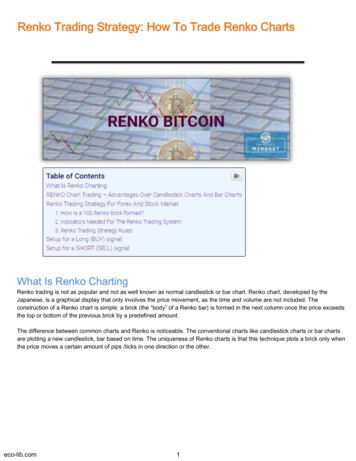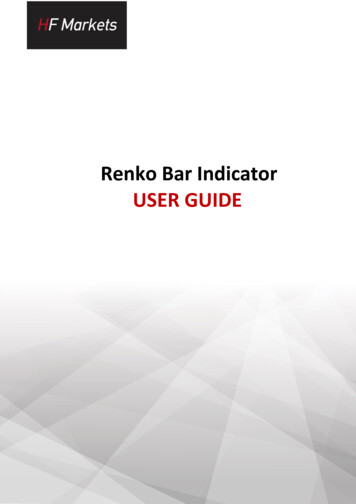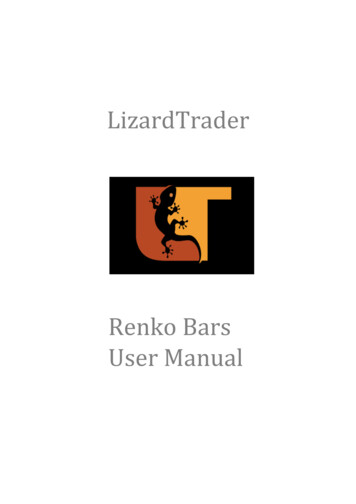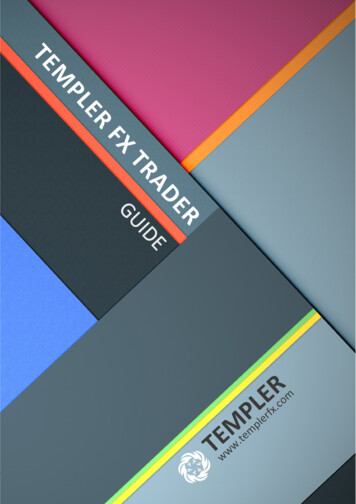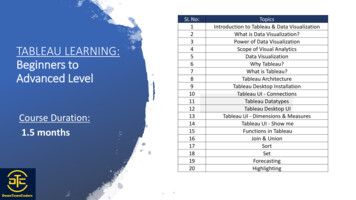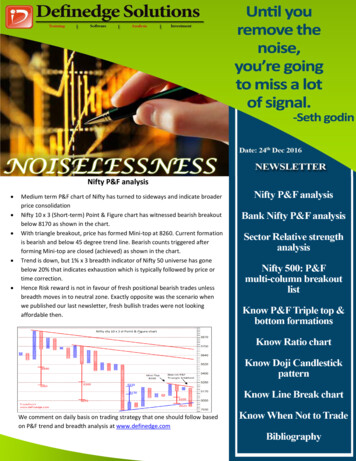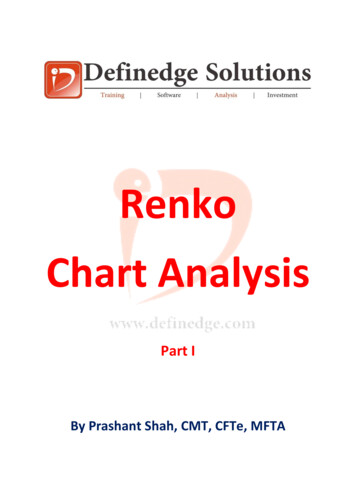
Transcription
RenkoChart AnalysisPart IBy Prashant Shah, CMT, CFTe, MFTA
www.definedge.comRenko Chart Analysis - Part IAbout author - Prashant Shah, CMT, CFTe, MFTAPrashant Shah is one of the few professionals with number of coveted and renowneddesignations in the industry. He has been awarded Chartered Market Technician (CMT) anda Certified Financial Technician (CFTe) by Market Technicians Association (MTA) andInternational Federation of Technical Analysts (IFTA) respectively. He is also a holder of theright to the Master of Financial Technical Analysis certification designation by IFTA for theoriginal research conducted by him on Line Break charts swing trading techniques.Prashant is founder member of Definedge Solutions and he has been practicing advancedform of Technical analysis for number of years. He is passionate about Designing systems,Training and Writing on Technical Analysis and Noiseless Charts in particular.Prashant.shah@definedge.com2
www.definedge.comRenko Chart Analysis - Part IIntroductionRenko charts have their origins in Japan and were used during the 19th century. It wasintroduced to the rest of the world by Steven Nison who discussed this methodology in hisbook, “Beyond Candlesticks”.Similar to the Point and Figure charts, the Renko charts too ignore time and volume. Same isthe case with Kagi & Line-Break charts. These time-independent charts plot only price actionthat is significant. The user has to decide the quantum of price move that is significantenough to be captured in the chart.Hence, these charts eliminate noise and lends themselves to easily readable chart patterns.Simplicity and objectivity are major advantages of these charts.Usual charts that we see such as bar or candlestick have got two dimensions - price andtime. Price is plotted on Y axis and the time on X axis. Charts move when the time passes by,irrespective of the price trend.Renko charts do not plot time and volume, they capture price action that is “significant”. Itfilters insignificant price moves or noise and focuses on what price is doing. Renko inJapanese means brick, that is why these charts are also known as Brick charts.ConstructionThe method of plotting Renko charts is slightly different compared to the traditional candleor bar charts. Renko charts are constructed or plotted by connecting two prices.Below is the image showing a simple line chart that is drawn by connecting closing prices.Price dots at 100 and 105 are connected by the line.Prashant.shah@definedge.com3
www.definedge.comRenko Chart Analysis - Part IInstead of connecting lines, Renko chart connects both the prices by drawing a box asshown in the image below.The box drawn by connecting both the prices is called a brick, hence the chart name Renko. So every brick would represent two prices - hence a brick has a high price and a lowprice. In the above example, low price of the brick is 100 and high price is 105.Brick shown above is bullish because price is going up, hence 105 which is the high price isthe current price. Typically, bullish bricks are drawn hollow while bearish bricks are filledwith colour. Charting software may use customized color coding for the bricks, which is fineas long as difference between bullish and bearish brick is easily identifiable. In this book,hollow bricks represent bullish price action and colored or filled bricks means bearish priceaction.In the same example, if price goes higher further to 110, another brick is drawn diagonal toprevious brick starting from its top right corner.In the new brick which is also bullish, low price is 105 and high is 110. Note that 105 is highprice of previous brick, and we drew current brick starting from that price.Prashant.shah@definedge.com4
www.definedge.comRenko Chart Analysis - Part IAnother bullish brick will be drawn in the similar manner if price advances further, seebelow image.Low price of recent brick is 110 and high price (recent price) is 115. Bricks will be formed inthe similar manner if price keeps moving up. But if price moves down and falls below lowprice of the previous brick, we need to draw the bearish brick. In the example shown above,current price is 115 and low price of the brick is 110. To call it a reversal, price has to movebelow 105 which is the low price of the previous brick.Below is the image showing bearish brick if price falls below 105.Prashant.shah@definedge.com5
www.definedge.comRenko Chart Analysis - Part IBearish brick is drawn diagonal to the bottom right corner of the previous brick. It isnormally filled with colour such as black or red so that we can easily distinguish betweenbullish and bearish bricks. In the above example, if price falls more and goes below 100 thenanother bearish brick will be drawn starting from the bottom right corner of current bearishbrick. If price moves up above 115, bullish brick will get plotted from top right corner ofcurrent brick.Brick valueThe Renko charts are helpful in removing noise from the data. This is achieved by definingthe “Brick Value. In the above example, notice the difference of 5 points, which is the BrickValue used in this case.By defining the Brick Value, the user can decide the price action that is significant enough tobe captured in the chart. In our example, a brick will be plotted only when price hastravelled by at least 5 points which is the chosen Brick Value.So if price moves from 100 to 105, a bullish brick is formed. Brick will not be formed if priceis even one tick below 105 So if price is at 104, the Renko charts will not move. Hence bydefining the brick value, we decide the frequency of bricks and the noise that we want toeliminate.Above chart can also be drawn by using other brick values but the principle remains same.We will discuss how to decide the brick value. Before that, notice in the last example thatbecause it is a 5 brick value chart, the next bearish brick will be plotted if price goes to 100and a bullish brick will be plotted if price goes to 115.So rules for forming the bullish or bearish bricks are clear and objective. Objectivity andnoiselessness are two most important advantages of Renko charts, besides their visualappeal.For clarification, if next bullish brick is to be plotted at 115, we'll plot it also if price touches115 or exactly at the same price. If bearish brick has to be plotted at 105, we'll plot it also ifprice touches 105.ExerciseLet's do an exercise to build a Renko chart to be comfortable with basics. Below is a pricetable to plot 10 brick value Renko chart. I recommend serious readers to try it first on thetable given below it. Explanation to plotting of every price is followed thereafter.Prashant.shah@definedge.com6
www.definedge.comRenko Chart Analysis - Part IPrashant.shah@definedge.com7
www.definedge.comRenko Chart Analysis - Part IThe method we adopt to plot Renko chart is that we define the scale as per brick valuechosen to keep it a round number for better readability. If we choose the brick value as 10,the scale used will be 100, 110, 120 and so on.Let's begin with the first price. We cannot plot first price simply because we don't knowwhether we need to start with bullish brick or bearish brick. Because it is a 10 brick valuechart, if price goes up by 10 points we'll begin with bullish brick and if it goes lower by 10points, we'll start with bearish brick. Renko chart cannot be plotted with just one price,hence we'll wait for another price.Second price is 110.20,meaning that is going up. Hence we begin with the bullish brick anddraw it as shown in the image below.Number '2' written above the brick is a price series number for the reference.Next brick will be plotted if price goes to 120 or fall below 90 (low price of previous brick),any price that occurs between these two is insignificant and considered as noise for thisbrick value Renko chart.Third and fourth price remains between the two levels and doesn't allow plotting. Fifth pricehas gone above 120 hence bullish brick needs to be plotted. Sixth and Seventh price doesn'tallow plotting before eight price that falls below requirement of bearish brick price level.Prashant.shah@definedge.com8
www.definedge.comRenko Chart Analysis - Part INinth price allows reversal from bearish to bullish brick when price moves back above 120.Next bullish brick level is 130 and bearish brick level is 100. Eleventh and twelth priceremain between the band. Thirteenth price allow bullish brick when moved above 140.Fourteenth price doesn't allow plotting. Below is the status of plotting so far.Prashant.shah@definedge.com9
www.definedge.comRenko Chart Analysis - Part IIf you can follow the plotting so far, the rest of the sequence should be easy to comprehend.As an exercise in learning to plot Renko chart, please use the data given the table below andplot the remaining price action and check with the chart displayed below.Prashant.shah@definedge.com10
www.definedge.comRenko Chart Analysis - Part IPrashant.shah@definedge.com11
www.definedge.comRenko Chart Analysis - Part IThe chart shown above is real time daily closing prices of Hindalco between 2013 and 2014.Below is the chart showing the same.High - Low Renko chartWe plotted Renko chart with closing price in the method shown above. As observed earlier,Renko charts can be plotted with only one price.A.W. cohen did remarkable job in the field of Point & Figure charts when he devised thehigh-low method of plotting them in his brilliant work during late 1950s. Same method canbe implemented for plotting Renko charts as well. Instead of closing price, High and lowprices of a particular period can be utilised for plotting the chart. To plot Renko charts withthis method either high price or low price of a particular period needs to be considered. Therules are as follows: If price forms new high and qualifies for next bullish brick, the low price is to beignored and bullish brick is to be plotted connecting the high pricesAfter forming a bullish brick, if price doesn't form new high price to qualify thebullish brick, then consider the low price of that period to check whether criteria forformation of bearish brick is fulfilled, if yes, plot bearish brick. if no, move on.If price forms new low price and qualifies for bearish brick, consider low price of thenext period first to check whether another bearish brick can be formed. If yes, form abearish brick. If no, check high price of the period to check whether reversal criteriais fulfilled.Prashant.shah@definedge.com12
www.definedge.comRenko Chart Analysis - Part IHence, with this method, we consider high price first if last brick was bullish and low pricefirst if last brick was bearish.Below is a price table and chart showing brick wise explanation of construction of High-lowRenko chart.High-low Renko charts are more dynamic and more aggressive.Prashant.shah@definedge.com13
www.definedge.comRenko Chart Analysis - Part IOne key difference between Renko and P&F chart is that we don't have to define thereversal method /value in Renko chart. We only need to define Brick value to plot the Renkochart which makes decision making quite simple.Log brick-valueWe discussed formation of Renko chart using absolute values such as 5 or 10. Renko chartcan be plotted with any such number. But often a chart moves in a wide range which makesdefining the brick value difficult. A chart like Aban offshore, that was at 5000 at some pointin time and it went to 200 from there as well. If I am using a brick value of 50 at 5000, itbecomes 1% of that price but what if I am using the same brick value and price falls all theway till 200?!!The brick value here is no longer 1% but 25% of the price! This is the major issue withlooking at larger duration Renko chart with absolute numbers.Technology comes as a saviour to deal with this issue. We can use log-scale and log-brickvalues to plot Renko chart. So if we use 1% log scale, a bullish brick will get formed if pricemoves higher by 1%. Same way next brick when price moves 1% higher again. Bearish brickwill get formed if price goes below the low of previous brick. Bullish brick from bearish willget formed if price moves higher than high of the previous brick. The principle remainssame, but log brick value is utilised instead of absolute value.Below is the Renko chart of Hindalco with 1% brick value.Below is the chart of Bhel plotted with 5 brick size Renko.Prashant.shah@definedge.com14
www.definedge.comRenko Chart Analysis - Part IBhel was trading around 300 during Feb 2015 and it traded below 100 during March 2016.Chart looks good but difficult to trade in the later stage because of brick size issue. In simplewords, 5 brick size when it was trading at 300 becomes 1.66% of price, and when it istrading at 100 becomes 5% of the price. So the same brick size cannot be followed and itneeds to be altered with the changes in price which is normally a very difficult task. So, alonger-term chart would be difficult to analyse with an absolute brick size.Log bricks are of great advantage. Below is the Renko chart of Bhel plotted with 5% bricksize for the same period.Prashant.shah@definedge.com15
www.definedge.comRenko Chart Analysis - Part IBrick size changes as per the price level due to the log scale which is accurate and practicallypossible to be followed. Notice the chart shown above where bricks are large because pricelevel was high and they become smaller as price fell to lower levels.This allows user to plot consistent chart and most importantly, make them practically tradeable. Below is the Bhel chart plotted with 1.5% brick size for the same period. Compare itwith the figure 1 and notice the difference in the latter part when stock started falling.Prashant.shah@definedge.com16
www.definedge.comRenko Chart Analysis - Part IGreat advantage of Log Brick charts is that they lend themselves to scanning foropportunities across an universe or group of stocks. 5 brick size for a stock trading at 1000and for the one trading at 100 is different hence scanning is impossible with absolute bricksize. But 1% across the chart remain 1% of the price irrespective of the price level that astock is trading at.We can therefore run a scanner for a strategy across a group of Renko charts with using logbrick value.Defining it with log scale brings compatibility and facilitates system testing. You can runscreeners around the group of stocks and it makes the chart analysis more simpler andlogical. Hence log Renko charts are preferable over other methods.ATR Brick valueLot of people and software use 14 day Average true range (ATR) as default brick value forRenko. Logic is that it considers volatility and shows the chart accordingly. The problem withthis kind of method is that brick value keeps changing along with the ATR. So if you enterbased on previous ATR based Renko chart, how to deal with it when ATR changes, resultingin a change in the brick value and chart structure. Hence log brick values are preferred overdynamic methods of determining brick values.Prashant.shah@definedge.com17
www.definedge.comRenko Chart Analysis - Part ITime frameIn traditional candlestick / bar chart, we can plot higher time frame charts by using monthly,weekly, yearly etc time-frames. We can achieve the same in Renko charts by adjusting thebrick value instead of using weekly, monthly or yearly prices.Instead of plotting charts using weekly or monthly price data, we recommend plottinghigher brick value charts using the daily price data in order to analyse the larger degreepicture.Hence, for short term analysis, you can use a 0.50% brick value based on daily chart. Use 1%brick value daily chart to get a medium term picture and 3% or 5% brick value to get a muchlarger degree picture.Below is a Renko chart of Tvs Motors plotted with 0.50% brick value.Same chart plotted with 1% brick shown below.Prashant.shah@definedge.com18
www.definedge.comRenko Chart Analysis - Part IYou can notice that brick values are compressed and noise is reduced.Below is a chart of TVS Motor plotted with 5% brick value to look at the larger picture.Prashant.shah@definedge.com19
www.definedge.comRenko Chart Analysis - Part IYou can see size of the brick increasing with the price. This is the advantage of log chartsand hence trend lines and other analysis becomes more logical on these charts.Same way, for intraday time intervals, I recommend one minute time frame to plot thecharts. One can use 0.25% brick value for stocks. I recommend 10 and 25 absolute brickvalue for Nifty and Bank Nifty charts on one minute timeframe. One can adjust these brickvalues as per the trading style and preferences. An aggressive trader, looking for morenumber of trades, can opt for a lower brick value. A momentum trader on the other handcan increase the brick-value in order to ride the trend.I can assure that whatever your style may be, following these simple charts will certainlyhelp you in filtering unnecessary trades and dealing with emotional issues and over trading.Brick ReversalA logical question after this introductory text is: Can one trade when color of the brickchanges? In other words, can we buy when filled brick (bearish) flips to a hollow (bullish)brick and vice versa? Simple answer is yes, but unfortunately, it is very difficult to follow thissimple looking strategy.This change of brick from bearish to bullish or bullish to bearish is called brick reversalpattern. A Bullish brick reversal pattern happens when a bearish brick changes to a bullishbrick. Similarly, a Bearish brick reversal pattern is formed when bullish brick changes tobearish. See image below.Brick reversal formations shows that price has changed the trend. How significant thatreversal event is something that requires more investigation.Brick reversal formations in higher brick-values chart are obviously more meaningful. Let’saddress this when discussion on Renko pattern analysis is completed.Prashant.shah@definedge.com20
www.definedge.comRenko Chart Analysis - Part ILet's begin our discussion on Renko chart analysis with conventional methods and patternsTraditional TheoriesI am avoiding detailed explanation on popular theories of analysis because there is so muchof literature already available.In the forthcoming section, all Renko charts have been plotted with 1% brick value on dailychart and they represent medium term price action. However, the concepts discussed willbe applicable on all brick values and timeframes unless otherwise specified.Support - ResistanceThe term support and resistance needs no explanation for those initiated into technicalanalysis. In simple terms, support is a level where demand is expected to overcome supplyand Resistance is a price level where supply is expected to overcome demand.All tools and methods of identifying support and resistance on usual charts are alsoapplicable in Renko charts. You'll observe that analysis becomes simpler on these charts dueto distinct feature of Renko charts of removing insignificant data to show clear picture.A. Support - Resistance linePrevious peaks and bottoms are treated as significant support and resistance price levels.We can plot horizontal line form those pivotal levels to draw support and resistance line.Refer Ajanta pharma Renko chart below showing support and resistance lines.Prashant.shah@definedge.com21
www.definedge.comRenko Chart Analysis - Part IDue to clarity in the trends that Renko chart captures, it is a visual treat to read them. In thechart shown above, horizontal lines are drawn from important tops and bottoms that actedas support and resistance.The concept of polarity principle where previous support when broken become resistanceand vice versa, is also clearly visible in the above chart. The arrows marked in the abovechart highlights the polarity principle.B. Renko support - Resistance setupDouble top and Double bottom are popular chart formations used in traditional price charts.Double top is a bearish reversal pattern that gets marked when two tops are formed atsimilar level and price falls below neckline (lowest point between two). Similarly, when priceforms two lows in the same zone and goes above neckline (highest point between two lows)of the pattern, it's a bullish reversal double bottom pattern. See image below.Prashant.shah@definedge.com22
www.definedge.comRenko Chart Analysis - Part IThe double top and double bottom patterns explained above can be identified on Renkocharts as well. Have a look at image the examples featured in the chart below.A double bottom pattern in Renko chart is characterised by two bearish bricks appearing ata similar level and a breakout above the neckline of the pattern.Similarly, price going below neckline after brick forming peaks at similar level is Double toppattern in Renko charts. If you notice, identification of such patterns are simple andobjective with Renko charts.Double bottom is a bullish pattern that shows price has taken support at the previouspivotal point. Similarly, double top is a bearish pattern that shows price has seen resistanceat previous peak point. Besides neckline, brick reversal formation provides opportunity totrade patterns. Brick reversal after forming support or resistance at previous brick is a firstPrashant.shah@definedge.com23
www.definedge.comRenko Chart Analysis - Part Iindication that price is respecting the level. If this formation is traded, it gives early entry butwith lesser stop. See the image below for examples.Renko double bottom support pattern can be identified when a bullish brick appears aftertwo bricks formed at similar level indicating support. Pattern gets negated if price goesbelow support brick.Renko double top resistance pattern gets formed when bearish brick occurs after twobullish bricks are formed at similar level. It's a bearish pattern that gets failed if anotherbrick is formed above resistance brick.Here is the chart of Gail showing Renko support and resistance setups.Prashant.shah@definedge.com24
www.definedge.comRenko Chart Analysis - Part IA reversal brick provides confirmation of the support and resistance level and it makes it aneffective setup.One can also chose to wait for the neckline break for confirmation but I recommend lowerbrick value charts in that case. More about this, in the later part of the book.Brick reversal filters out frequently appearing formations and other methods of analysishelps in identifying better trading opportunities.Multiple top or bottom patterns such as triple top - triple bottom formations can also beidentified in a similar manner. See the chart of Reliance capital below for example.Note that in case of triple top, double top also remains active because the top brick is notbroken by the price.There could be a question about targets and exit rules. I am restricting the discussion hereto patterns and analysis. Trading setups will be explained in detail in the later chapters alongwith objective rules.Prashant.shah@definedge.com25
www.definedge.comRenko Chart Analysis - Part IBelow is a recent chart of Reliance capital showing Renko triple top and triple bottoms.Pattern A is triple top confirmed by bearish brick reversal. Pattern B is not a triple bottombecause brick did not reverse immediately, though it did eventually. Pattern C is where brickdid not turn bearish hence not a triple top formation, in fact it is a resistance breakoutpattern.Below is a chart of SBI showing Renko support and resistance patterns.Prashant.shah@definedge.com26
www.definedge.comRenko Chart Analysis - Part IJourney from 150 to 150 has few Renko support - resistance patterns in between for you toobserve.Higher low - Lower highWhen price forms a low higher than the previous low, it is known as higher low or risingbottom pattern which is a first indication of bullish trend reversal formation. Same way,lower high is marked when price form a high point lower than the previous high, it's a firstsignal of potential top and significant trait of down trend. Brick reversal formations helps inidentifying these patterns. See chart of Ambuja Cement featured below.Triple top formation shown in the above chart is followed by a significant downtrend. Priceformed higher low formation at the bottom signalling impending reversal.C. Support - Resistance lineHorizontal trend line is another popular technique where a line drawn connecting multiplepeaks and bottoms to identify demand and supply zone.Below is a chart of Axis bank showing horizontal support - resistance lines on Renko chart.Prashant.shah@definedge.com27
www.definedge.comRenko Chart Analysis - Part IRenko double bottom setup at support line, and when price took support at previousresistance line are visible. Trade can be identified by using these concepts together.D. FibonacciThe Fibonacci sequence is named after Italian Mathematician Leonardo Pisa, known asFibonacci. He introduced the sequence to western world in the 12th century. It is said thatthis sequence has been described earlier as Virahanka numbers in Indian mathematics.Fibonacci sequence is series of numbers as shown below0, 1, 1, 2, 3, 5, 8, 13, 21, 34, 55, 89, 144, 233, 377 .Each number in the sequence is simply the sum of the two numbers before it. For example,2 is found by adding two numbers before it (1 1). Same way, 3 is found by adding twonumbers before it (2 1). and so on.Fibonacci numbers are treated as nature's number because it is said that they appear inevery nature, from the leaf arrangement in plants to pattern of florets of a flower etc. Thereare many natural things where this ratio is not found, and even if it does - it is not necessarythat it would be applicable to markets. I am mentioning it only to be aware that it is not amagical ratio. However, setups can be designed using it.Prashant.shah@definedge.com28
www.definedge.comRenko Chart Analysis - Part IIf one number of the series is divided by the number that follows it, the ratio will be 61.8% which is also referred as Golden ratio. If one number in the series is divided by the numberafter the next one in the sequence, the ratio we get is 38.20%. Same way, every number inthe sequence is 23.60% of the number after the next two numbers in the sequence.Fib retracements and extension is a widely followed tool to identify support, resistance andtargets. Traders who seek to trade when price correct, found Fibonacci ratios useful tocalculate the retracement to trends in the price charts . Generally, 23.60%, 38.20%, 50%,61.80% and 78.60% are treated as Fibonacci ratios. Actually 50% level has nothing to dowith Fibonacci sequence but traders use this level because of tendency of price to reverseafter retracing half of the previous move.It can be applied on Renko charts also. When these ratios are applied on a chart from anyswing move, we don't know which ratio will get respect from the price. Brick reversal canact as a tool of confirmation on Renko charts.See Renko chart of Grasim shown below with 23.60%, 38.20%, 50% and 61.80% Fibretracement applied on it.Price did not take support at 23.6% retracement and reversed from 38.20% ratio level,trading it with brick reversal becomes better business.Below is a chart of Grasim during late 2016.Prashant.shah@definedge.com29
www.definedge.comRenko Chart Analysis - Part IPrice retraced from 50% ratio level of earlier down swing move and formed Renkoresistance setup.Other Fib techniques such as extensions or Fib clusters can be applied in similar manner onRenko charts.Trend linesTrend line is another basic and popular tool used in technical analysis. They are drawn onthe chart mainly to identify trend. They are also useful tool to analyse support, resistanceand breakouts. A bullish rising trend line is drawn by connecting minimum two low pricesand bearish falling trend line is drawn by connecting minimum two peak points.Trend lines can be drawn in the similar manner on Renko charts. Connect bottom ofminimum two bricks to draw rising bullish line; or top price of minimum two bricks to drawfalling bearish line.Prashant.shah@definedge.com30
www.definedge.comRenko Chart Analysis - Part IBelow is a Renko chart of AIA engineering showing different trend lines.Trend line is A is a bullish rising line that connects the lows of bearish bricks. Trend line B is abearish falling line connecting top points of bullish bricks. Trend line C is a horizontal linedrawn by connecting peak points, it shows resistance that price cleared eventually, resultingin a breakout. Trend line D is relatively steep bullish line drawn by connecting bottoms.Below is a Renko chart of Reliance infra showing trend line breakouts.Point A and B shows downside breakout from bullish trend lines. Point C is a resistancetrend line breakout after price forming a double bottom formation.Prashant.shah@definedge.com31
www.definedge.comRenko Chart Analysis - Part IChannel linesChannel lines are plotted on a chart by drawing a parallel line to the trend line. The Imagefeatured below shows rising, falling and horizontal channel linesA rising line drawn parallel to a bullish trend line shows rising channel lines. Similarly, afalling channel line is drawn by plotting a parallel line to the bearish trend line. Horizontalchannel lines are plotted by drawing parallel line to a horizontal trend line .Below is a Renko chart of Abirlanuvo showing falling and rising channel lines.Prashant.shah@definedge.com32
www.definedge.comRenko Chart Analysis - Part IPatterns with trend linesTraditional chart patterns such as Head & shoulders, Cup - handle, Rounding top bottoms,Triangles etc can be seen on Renko charts as well. Attractive visual appearance and noisefiltration methods makes technical analysis much simpler and effective on Renko charts.Have a look at Renko chart of Tata steel shown belowSwing move B within swing move A. And Swing move C within swing mov
Renko charts have their origins in Japan and were used during the 19th century. It was introduced to the rest of the world by Steven Nison who discussed this methodology in his book, "eyond andlesticks". Similar to the Point and Figure charts, the Renko charts too ignore time and volume. Same is the case with Kagi & Line-Break charts.
